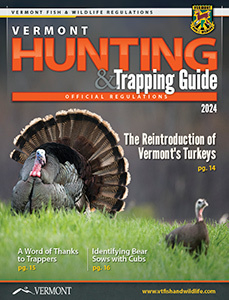Furbearer Hunting & Trapping
Furbearer Hunting Seasons
Species |
Season |
Bobcat |
Jan. 10 – Feb. 7 |
Red & Gray Fox |
Oct. 28, 2023 – Feb. 11, 2024 & Oct. 26, 2024 – Feb. 9, 2025 |
Raccoon |
Oct. 12 – Dec. 31 |
Muskrat |
Mar. 20 – April 19 |
Opossum, Skunk, Weasel |
No Closed Season |
Coyote |
See VTF&W website for season |
Beaver, Otter, Mink, Fisher, Marten, Lynx, Wolf, Mountain Lion |
No Open Season |
Furbearer Trapping Seasons
Species |
Season |
Mink, Skunk, Red & Gray Fox, Raccoon, Coyote, Opossum, Weasel |
Oct. 26 – Dec. 31 |
Otter, Muskrat, Beaver |
Oct. 28, 2023 – Mar. 31, 2024 & Oct. 26, 2024 – Mar. 31, 2025 |
Fisher |
Dec. 1 – 31 |
Bobcat |
Dec. 1 – 16 |
Marten, Lynx, Wolf, Mountain Lion |
No Open Season |
Furbearing Animals
The following are classified as furbearing animals: beaver, otter, marten, mink, raccoon, fisher, fox, skunk, muskrat, bobcat, coyote, weasel, opossum, lynx, and wolf.
Trapping License Requirements
An applicant for a trapping license must have either:
- A previous or current trapping license from any state or Canadian province; or
- A certificate showing satisfactory completion of a trapper education course, in any state or Canadian province; or
- A signed affidavit attesting to having a prior trapping license.
It is mandatory for trappers to fill out and return an Annual Trapper's Report for each year they possess a trapping license.
Fur Buyer’s License
Anyone dealing in pelts must have a valid fur buyer’s license. The fur buyer’s license is available from Vermont Fish & Wildlife in Springfield (phone 802-289-0613).
Trapping License Required of Wildlife Control Trapper
A person who for compensation sets a trap for rabbits or furbearing animals on the property of another person in defense of that property shall possess a valid trapping license, and complete and return a mandatory trapper report.
Coyote Hunting Competitions Prohibited
It is illegal to participate in a coyote hunting competition for a prize. Fine for first offense is $400 to $1,000 and ten points on a hunter's license and second offense is $2,000 to $4,000 and twenty points on a hunter's license.
Raccoons
- A person shooting raccoons during the raccoon hunting season shall use a .22 caliber rimfire firearm or a shotgun with #2 shot or smaller.
- A light may be used to illuminate and shoot a raccoon once treed by a dog, or dogs, during the raccoon hunting season. A light may also be used to illuminate a raccoon once treed by a dog, or dogs, during the training season.
Furbearer Hunting & Trapping Methods
Vermont’s primary furbearer regulation (10 V.S.A. Appendix §44) was being amended while printing this guide and may change during 2024. When available, an updated regulation will be found on our website at https://vtfishandwildlife.com/hunt/hunting-and-trapping-opportunities/furbearers-and-trapping/furbearer-hunting-and-trapping. Trappers and hunters are responsible for knowing and following current regulations.

